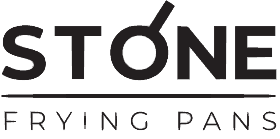How To Use Cast Iron On Glass Top Stove (Without Scratches)
Is it OK to use cast iron on glass top stove?
The short answer is...YES!...... but...
You're nervous. And we get it.
You'll want to protect the glass top surface and prevent scratches. After all you spent good money on the stove.
Fear not, you're at the right place. We show you how.
Let's dig in.
But first, let's talk about the glass top stove.
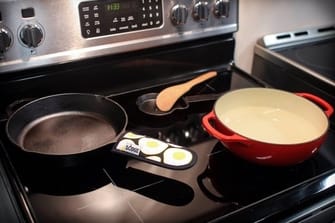
What’s the Appeal of the Glass Stove Top?
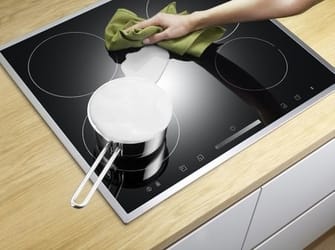
One of the big appeals of a glass stove top is its smooth surface that makes it easy to clean up.
The flat surface means there are no spaces between coils where food can spill.
Another advantage of the glass top stove over the coil stove is that the smooth surface is level, ensuring that heat is evenly distributed through induction.
When it comes to what cookware works best on a glass top stove, pots and pans that are medium to heavyweight and that have a flat bottom are highly recommended. Stainless steel is the most popular, followed closely by copper pans and aluminium.
So what do you do when some of your favorite cookware is cast iron or glass? Do you replace those pots and pans for stainless steel just because you have a new glass top stove?
Again, Can You Use Cast Iron On a Glass Top Stove?
One of the biggest disadvantages of glass top stoves is that the surface is easily scratched by cookware. It’s recommended that some types of cookware not be used on a glass top stove, such as glass, stoneware, and cast iron stove top pans.
Let’s look at why.
The Weight of Cast Iron Pans
When a stove has glass over the top, cast iron can easily scratch and damage the surface.
The main reason for this is the weight of the pan – cast iron is heavy. Add food to the pot, such as soups and stews, and the pot is even heavier.
And that’s a lot of weight resting on top of the glass cooktop.
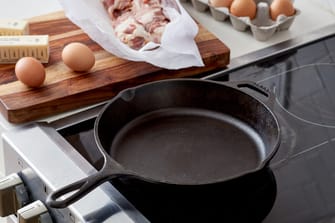
Of course glass cooktops are designed to handle a lot of weight. But if you even slightly drop that cast iron pan on the surface while you’re lifting it, the stovetop can easily crack, permanently damaging your glass top stove that now needs to be replaced.
Uneven Bottom of Cast Iron Cookware
The best cookware for glass top stoves are ones that have a flat bottom so that heat can be evenly distributed throughout the bottom surface of the pan.
Cast iron pans usually don’t have a perfectly flat bottom, but rather have rough spots and burrs on the bottom. This can easily scratch the glass top, sometimes leaving behind deep scratches that can cause discoloration in the stove surface.
The Size of Cast Iron Pots and Pans
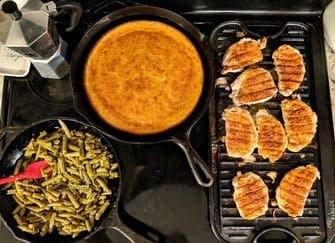
Still another reason why glass stove top manufacturers steer you away from using cast iron cookware is the size. Many of the cast iron pots and skillets we use are larger than the burners on the stove.
For heat efficiency, the recommended cookware size for glass stove tops is that it be no more than one-inch bigger than the burner. If cast iron pans are too big, the heat won’t be distributed evenly across the bottom surface which can lead to food taking much longer to cook.
The large size of cast iron cookware can also damage or reduce the life of the heating element when it traps heat of long periods of time underneath its bottom surface.
The Surface Finish of Cast Iron
The surface finish of cast iron pans is rough rather than smooth. And this rough surface, along with an uneven bottom, can quickly scratch the glass top. One exception is if you purchase cast iron that is coated with a porcelain enamel, which makes the pan smooth with a more even finish.
Here's How to Protect Glass Top Stove From Cast Iron?
Despite all the warnings about not cooking with cast iron on glass top stoves, there are some things that you can do to protect your stove and still cook with cast iron without damage or scratches.
Lift....... Don’t Slide!
If you’re going to use your favorite cast iron pan on your new glass top stove, you’ll have to get into the habit of lifting rather than sliding the pan.
Even if you have to move the pan just slightly so it sits better over the element, lift the pan instead of sliding even half an inch.
Also be careful not to drop the pan.
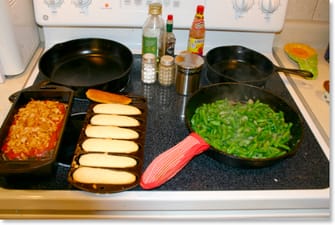
As mentioned previously, cast iron gets very heavy when it’s filled with food and the pan is easier to drop than other cookware. Always lift with both hands to be sure you have a good grip – then set down carefully in one place so you don’t scratch.
Before Heating, Wash Cast Iron
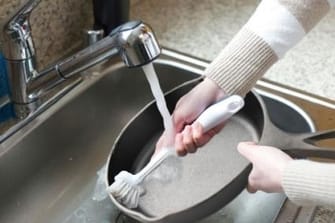
Don’t just wash your cast iron cookware after you’ve finished using it, wash it again before you put it back onto the glass surface.
Cast iron pans collect more oil and small deposits of cooked on food than any other type of cookware. This means that when you heat up the cast iron pan the oil and deposits of food can start to carbonize and burn, leaving stains and smudges on the glass top surface.
And sometimes these stains can be difficult to remove from the glass top. Washing cast iron both after using and thoroughly again before cooking with it can prevent damage to the stove top.
Using a Heat Diffuser
A great way to cook on glass top stove and use your cast iron pan is to cook with a heat diffuser. Just what is a heat diffuser?
A heat diffuser does just that – it’s designed to diffuse the heat and distribute it throughout the bottom surface of a pan. Made with durable metal, heat diffusers can also help protect your glass stove top from the heaviness and the rough bottoms of cast iron pans. One way to think of heat diffusers is that they’re a buffer between the bottom of any pan and the surface of the stove.
You can pick up heat diffusers at any kitchen or home and hardware store for a low price. Just place the diffuser on your glass stove over an element, carefully place the cast iron pan over top, and heat to medium.
Be careful that the heavy weight of the pan doesn’t shift the diffuser away from the heating element.
Now you can cook as you normally would, without the risk of scratching the stove surface with your cast iron pan.
There is one caution to take when using a heat diffuser on a glass top stove – keep an eye on the temperature. If you heat the diffuser to a high heat, it may damage both the heating element and the surface of the stove. Never heat up a diffuser on the stove without having cookware with food over top.
How Do I Prevent Scratches On My Glass Stove Top?
When a stove has glass over the top, cast iron and other pans can easily damage the surface. Here are some tips for preventing scratches on the glass top of your stove:
- 1Use caution - As with cast iron cookware, be cautious when cooking with stoneware and ceramic. Both types of pans can cause scratches and damage the glass top, so follow the same cooking rules as for cast iron.
- 2Moving the pan - The same goes for moving any pan around the surface of the stove. Get into the habit of carefully lifting and placing any pan that you’re cooking with. Otherwise, over time, the surface of your stove will be sure to have scratches that make it look uncared for.
- 3Don't use - Avoid using cookware that has round bottom edges. Choose flat bottom pans that are more stable when sitting on the stove top, with less chance of them moving or shifting and causing scratches.
- 4Handling Spills - As soon as spills happen, take the time to carefully wipe and clean them away. Food that spills onto the surface will very quickly burn and cook onto the stove top, making it difficult to clean later.
- 5Clean, clean, and clean - Keep your cookware clean! After cooking, make sure the bottom of the pot is clean of any food deposits or grease. As with cast iron, if you cook with pots that have a dirty bottom, the heat from the element will cause the grease to soften, heating into the surface of the stove and leaving marks that may be stubborn to remove.
- 6Cooling - When pulling pans from the oven, whether glassware or metal, avoid putting them directly onto the stovetop to cool down. Place a wire cooling rack over the stove first. Or place on the counter on top of a clean tea towel. Otherwise the heat from the cookware that was in the oven may leave marks of discoloration on the glass surface.
- 7Use Proper Utensils - When cooking, use a spoon tray to hold any utensils that you’re using. Placing utensils, such as spoons and whisks, onto the glass top stove can burn or scratch the surface.
- 8Surface Top - Never put anything other than cookware onto the surface of your glass top stove. Although it can withstand high heat, it can’t withstand heavy weight, such kneeling or standing on it to reach into a higher cupboard or onto an overhead shelf.
How Do I Clean My Glass Top Stove?
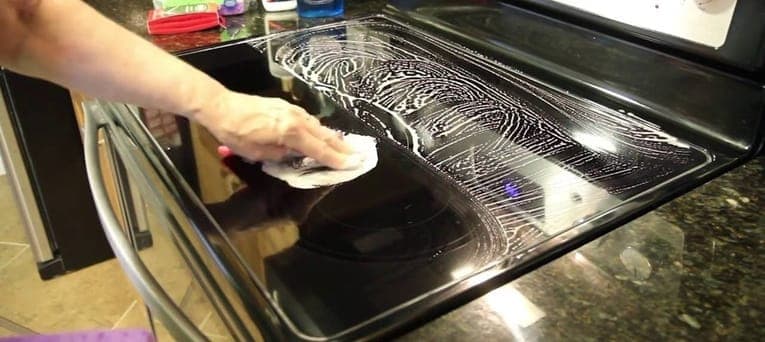
As well as doing what you can to avoid damage and scratches from cooking with cast iron pans, you’ll want to keep your stove looking clean and brand new. Here are some of the ways to effectively clean glass top stoves.
General Cleaning Rules
Tips for Daily Cleaning
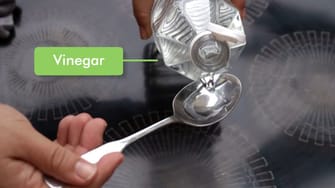
After every use, wipe down the surface of the stove so that residue and dust doesn’t collect.
When the surface is cool, spray water or vinegar, or a mixture of both, onto the stove top. Use a soft cloth to wipe clean, being sure not to leave behind any scuffs or streaks.
Cleaning Dirty Glass Top Stoves
Once a month, give your stove a thorough cleaning.
On the cool stove top, spray all over with vinegar. Sprinkle baking soda over the vinegar, letting it bubble for one minute.
Using a soft cloth that’s been soaked in hot water and wrung out, place the cloth over the stove top.
Leave for about 10 to 20 minutes.
Then remove the cloth and use a new clean, damp cloth to wipe up the vinegar and baking soda.
Use a solution of vinegar and warm water to remove any lingering streaks or scuffs. This is a great way to leave your glass top stove looking brand new for a long time.
How Do I Clean Stubborn Burnt On Food?
Whether you cook with a cast iron pan, or any other pan, there are going to be those stubborn burnt-on rings and food residue that just won’t come off with regular cleaning. For this, use a razor blade.
Spray the area with a solution of warm water and vinegar. Leave to soak in for a few minutes so the residue becomes softer.
Gently use the razor blade to scrape the food or oil residue. Do this at a sharp angle so that you’re not scratching the surface of the stove. Wipe clean with a soft cloth.
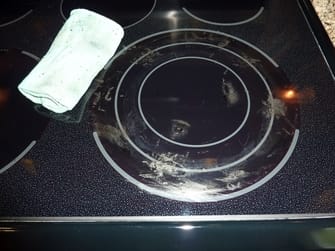
You may have to repeat this one or more times. Note: check to see the instruction booklet – some glass stove top manufacturers warn against using a razor blade to clean.
Bottom Line
With the information here, you’re ready for cooking with your glass top stove using cast iron pans or any other cookware.
We recommend either a Stone Frying Pan or induction cookware for your kitchen.
